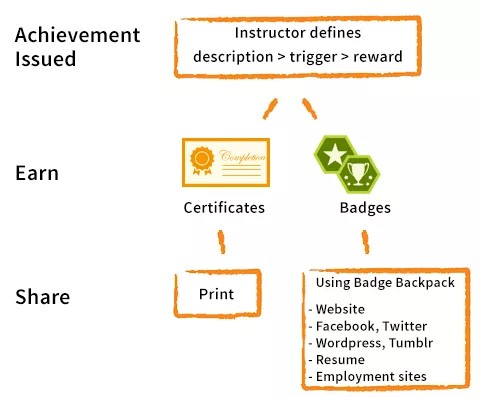This information applies only to the Original Course View. Your institution controls which tools are available.
Being rewarded is a powerful extrinsic motivator. One of the best rewards is recognition for a job well done. You can reward your students throughout your course to keep students motivated and create a map of what they can learn. You can use certificates and open badges to round out a grade. You can provide details and examples of exactly what students achieved in your course.
These certificates and open badges go with students. These rewards help students to communicate an identity and reputation of accomplishment in their fields of choice. These achievements can help open job and education opportunities, as well as unlock new privileges.
What are achievements?
You can use Blackboard achievements to create opportunities for students to earn recognition for their work. You designate criteria for issuing achievements to students in the form of both badges and certificates.
Students can see which badges and certificates they have earned and what is required to receive additional recognition. They can gain insight into learning progression toward defined competencies.
Students can publish badges to the Badge Backpack and transport evidence of their learning outside of Blackboard Learn. To learn more about Badges and Badge Backpack, visit Badge Backpack (available in English only).
Depending on your version, some areas within Learn may still refer to the Badge publisher as Mozilla rather than Badgr.
Watch a video about badges
The following narrated video provides a visual and auditory representation of some of the information included on this page. For a detailed description of what is portrayed in the video, open the video on YouTube, navigate to More actions, and select Open transcript.
Video: What is a Badge? explains what a badge is and how you can use them in education.
The lure of badges
Use gaming elements, such as competition, scoring, levels, and badges to engage users.
If you've watched a teenager play World of Warcraft, you know how the digital universe motivates people. You can also motivate your students with a form of "gamification" with badges. With the achievements tool, you can design a badge system to encourage your students to explore and participate more.
You can award badges for the completion of a project, skill proficiency, or levels of experience. Students' badge collections can represent the key learning milestones that they met. Earned badges can show a complete view of a person's skills and achievements.
You can also award badges for skills and knowledge acquired outside of the classroom setting:
- Extra-curricular activities and after school programs
- Volunteer programs and community service
- Work-related projects
- Military experience
- Study abroad
- Student government
- Membership in a club, group, or other organization
- Internships and mentorships
- Job training
- Soft skills, such as collaboration, leadership, and community-building
Basically, you can allow students to combine a diverse set of badges to tell the story of their accomplishments, in and out of class. Together, you can create badges to spotlight skills that will help students work toward a specific goal. Whether the goal is to gain admittance into graduate school or find the perfect job, you can collaborate with your students to design the pathways.
When students are included in the process that unlocks the access to what they want, you may see a spike in their motivation for additional learning. You want to facilitate your students' "what if" thinking stage. Allow them the flexibility to be innovative and determine what they value and recognize as important to their own educations.
Questions to consider
Will you organize your badges into groups?
To help engage your students, you can "tier" your badges. After your students earn one badge, they unlock the next badge. The difficulty in earning the badge doesn't necessarily have to increase. You can let students follow your recommended path for earning badges or design their own learning experiences.
Are privileges attached to badge collecting?
You can provide other types of incentives for earning badges. For example, after earning badges A, B, and C, you can offer your students a coveted internship. When associated with something they value, your students might be more motivated to earn badges.
After your badge system is in place for a period of time, you may find that other incentives beyond badges aren't necessary.
Should badges be made public?
Excerpt from: Schenke, Tran, and Hickey. "Design Principles for Motivating Learning with Digital Badges." HASTAC. 5 June 2013. Web. 17 July 2013.
Thanks to Mozilla's Open Badges Infrastructure, badge earners in most projects can decide if and when to publicly display badges they are currently working on or have earned. Some projects give earners the option of displaying badges themselves, while other projects automatically display badges for learners. We know from the motivation literature that providing choice makes learners feel more autonomous (in control), and that different levels of choice have implications for motivation. However, displaying badges to the public may induce competition among badge earners.
As students collect badges, they determine how potential employers, organizations, and schools can view them. Students can post their badge collection on Mozilla Open Backpack, social networking profiles, personal websites, college applications, job search sites, and online résumés.
With credible information included with badges, they become the evidence of a person's skills, competencies, accomplishments, experiences, and talents. Anyone can explore badge data to verify their worthiness.
As the value of badges increases, they can help unlock new possibilities for lifelong learning.
Who is your audience?
As you create your badges, think about who may want to access the evidence behind them:
- Badge earners
- Graduate schools
- Peers who might motivated by the achievements of others
- Colleagues and professionals in your field you want to network with
- Those who can provide internships and mentorships for your students
- Potential employers
These people all help with the sustainability of your badge system through time.

